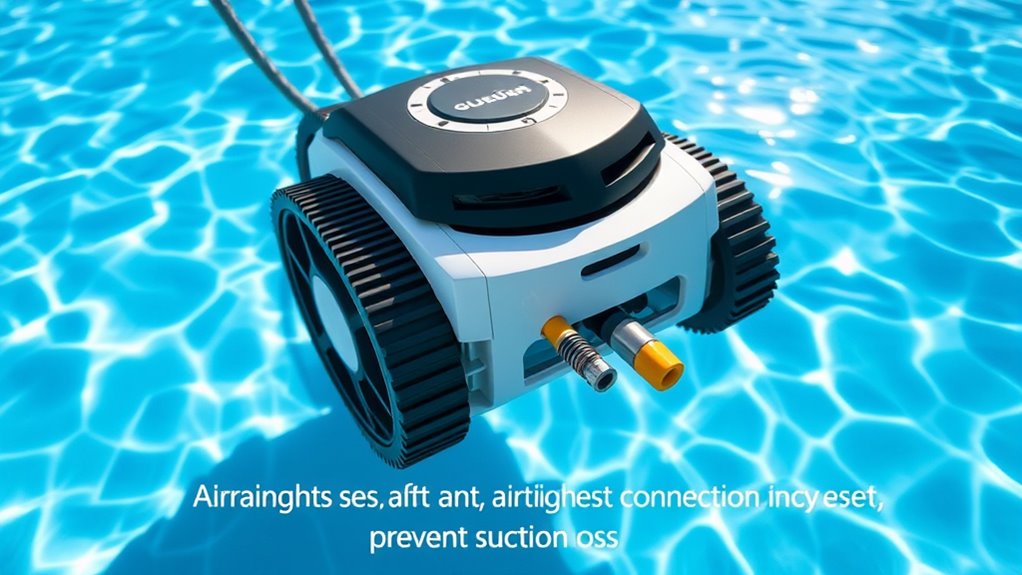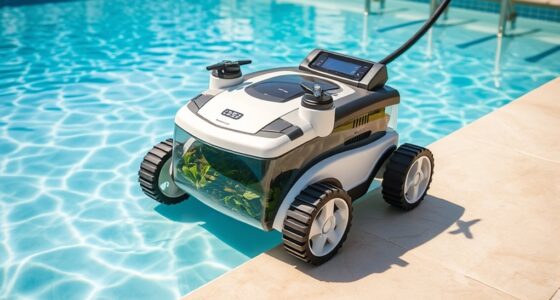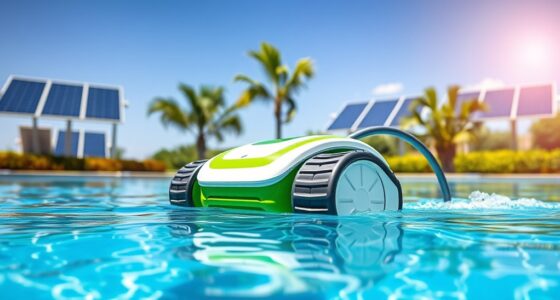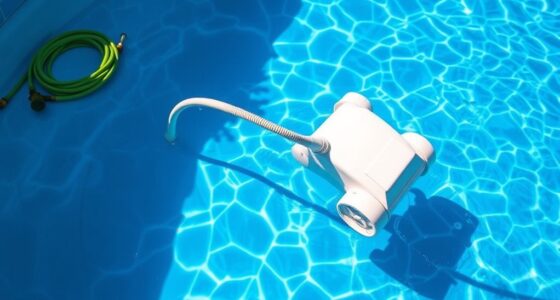To prevent suction loss in your pool cleaner, regularly inspect and clean the skimmer and pump baskets, ensuring they’re free of debris. Keep water levels properly maintained, generally near the skimmer opening, and check that hoses and connections are tight and leak-free. Remove obstructions from pool lines and jets, and replace worn hoses or seals promptly. Proper filter maintenance and system checks are also essential. Following these steps can keep your pool cleaner operating smoothly—learn more tips to keep your pool spotless.
Key Takeaways
- Regularly inspect and clean skimmer baskets, hoses, and connections to prevent debris buildup and leaks.
- Maintain proper water levels using indicators to ensure optimal suction and pump performance.
- Clear obstructions from pool lines, jets, and skimmer baskets to ensure smooth water flow.
- Keep filters clean and balanced chemical levels to avoid clogs and debris affecting suction.
- Schedule routine system inspections and replace worn hoses or seals promptly to prevent leaks and suction loss.
Regularly Inspect and Clean the Skimmer and Pump Strainer Baskets

To keep your pool cleaner’s suction strong, it’s essential to regularly inspect and clean the skimmer and pump strainer baskets. These baskets trap debris before it reaches your pump, ensuring smooth water flow. Over time, leaves, dirt, and other debris can clog the skimmer basket and pump strainer, reducing suction and impairing your cleaner’s performance. Remove the baskets weekly and empty them thoroughly. Rinse them with a hose to clear out stubborn debris and prevent blockages. Make sure the baskets fit snugly back into their housings to avoid leaks. Regular maintenance prevents clogs, maintains ideal water flow, and prolongs the life of your pool equipment. Keeping these components clean is a simple yet effective way to ensure your pool cleaner functions efficiently. Additionally, using high-quality filtering equipment can further improve water flow and reduce the frequency of cleaning needed. Proper water flow management also helps prevent suction loss and extends the lifespan of your pool’s filtration system. Regularly inspecting and replacing worn or damaged seals and gaskets can also prevent leaks that reduce suction efficiency. Monitoring your pool’s filtration system regularly can help identify issues before they cause significant performance problems. Incorporating routine maintenance into your pool care routine can ensure consistent, optimal suction and cleaner operation.
Check and Maintain Proper Water Levels in Your Pool

Keeping your pool’s water level just right is key to preventing suction loss. You should check the water level weekly and make adjustments as needed. Using a water level indicator can help you maintain the proper level consistently.
Monitor Weekly Water Levels
Regularly checking your pool’s water levels is vital for preventing suction loss in your pool cleaner. Consistent water level monitoring helps verify the skimmer and pump operate correctly, maintaining suction stability. If water drops too low, the cleaner may lose suction, leading to inefficient cleaning or damage. Conversely, overly high water levels can cause water to bypass the skimmer, reducing suction effectiveness. By measuring your water levels weekly, you can catch and address any fluctuations early. Keep an eye on the water line relative to the skimmer opening, making sure it stays within the recommended range. Proper water level management supports steady suction, prolongs your cleaner’s lifespan, and keeps your pool sparkling. Staying vigilant about water levels is a simple yet vital step in pool maintenance. Additionally, understanding how automation’s role in business intelligence can streamline monitoring processes may help you set reminders or alerts for maintaining optimal water levels. Implementing sensor technology to monitor water levels continuously can further improve accuracy and reduce manual checks, making your pool care routine even more efficient. Maintaining correct water balance can also prevent issues that contribute to suction loss, ensuring your pool stays clean and functional. Using digital tools to automate water level checks can further enhance your pool care routine, making maintenance more efficient and less prone to oversight.
Adjust Water Level Regularly
Adjusting your pool’s water level regularly guarantees the cleaner maintains ideal suction and performance. Consistent water level adjustments help prevent the cleaner from losing suction, which can lead to inefficient cleaning. To keep your pool water balance perfect, check the water level at least once a week, especially after heavy use or rain. The correct level should be near the skimmer opening or the midpoint of the pool’s tile line. If the water is too low, the cleaner won’t get enough water flow, risking suction loss. Conversely, too high a water level can cause the cleaner to struggle with movement. Regular adjustments ensure proper water flow, supporting consistent pool water balance and prolonging your cleaner’s lifespan. Maintaining proper water flow is crucial for optimal pool cleaner function and longevity. Additionally, understanding the importance of water circulation can help prevent issues with suction loss and improve overall pool health. Monitoring the water level also helps maintain the right balance, preventing strain on the pool’s filtration system and ensuring efficient operation. Proper water level management can further optimize your pool’s overall performance and extend the lifespan of your cleaning equipment. Regularly checking your pool’s water quality can also support cleaner efficiency and overall swimming conditions.
Use Water Level Indicators
Using water level indicators makes it easy to monitor your pool’s water level accurately. These indicators help you quickly identify whether the water is too low or too high, ensuring ideal pool water stability. When the water level drops below the recommended mark, your pool cleaner may lose suction, leading to inefficient cleaning or damage. Conversely, if the water is too high, it can cause overflow or reduce the cleaner’s effectiveness. Regularly checking water level indicators keeps you aware of fluctuations and prompts timely adjustments. Maintaining proper water levels is essential for optimal pool cleaner performance and prevents unnecessary wear on your equipment. Additionally, proper water maintenance can prolong the lifespan of your pool and its components. This simple tool helps prevent suction loss by maintaining consistent water levels, safeguarding your equipment, and enhancing your pool’s overall performance. By staying vigilant with water level indicators, you ensure your pool cleaner operates smoothly and effectively. Proper water circulation is also crucial for keeping your pool clean and balanced, contributing to a healthier swimming environment. Incorporating advanced fraud detection techniques can further protect your equipment from malicious interference, ensuring reliable operation over time. Understanding the history of pool cleaning technology can also help you choose the most effective solutions for your needs.
Ensure Hoses and Connections Are Secure and Free of Leaks
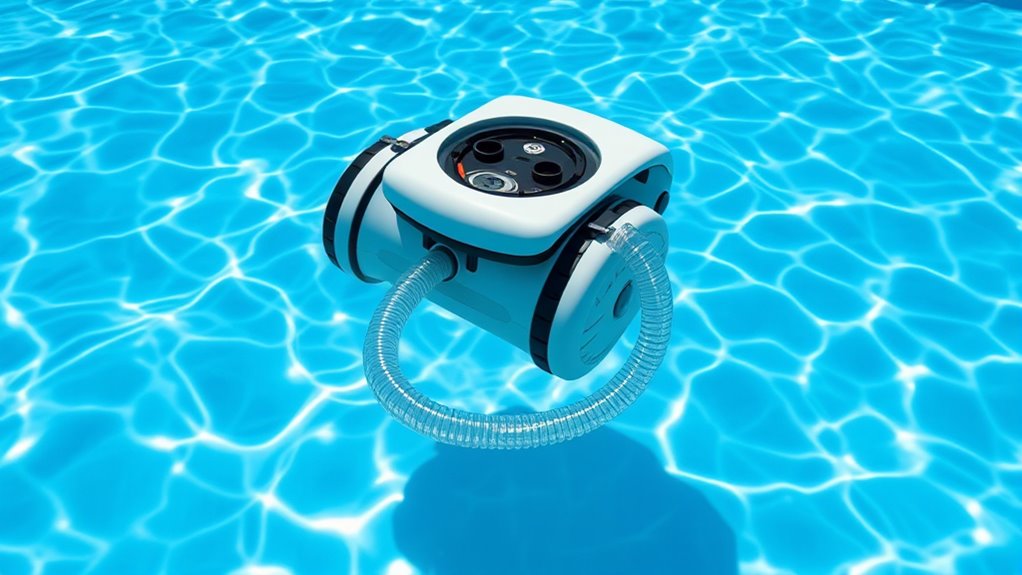
To prevent suction loss, you need to make sure all hoses and connections are secure and free of leaks. Check each connection point for hose leaks, ensuring they’re tightly attached and sealed properly. Loose or damaged connections can considerably reduce suction power. Regularly inspect hoses for cracks or wear and replace any compromised sections. Here’s a quick guide:
| Connection Point | Check for Hose Leaks | Secure Connection |
|---|---|---|
| Pump to Hose | Yes | Tighten if loose |
| Hose to Cleaner | Yes | Reattach firmly |
| Skimmer or Inlet | Yes | Seal properly |
Maintaining connection security prevents suction loss and keeps your pool cleaner running smoothly. Additionally, understanding water flow dynamics can help you troubleshoot and optimize your system effectively, preventing further suction-related issues that could impair performance. Proper system maintenance is also essential for long-term efficiency and reliability.
Clear Obstructions From Pool Lines and Jets
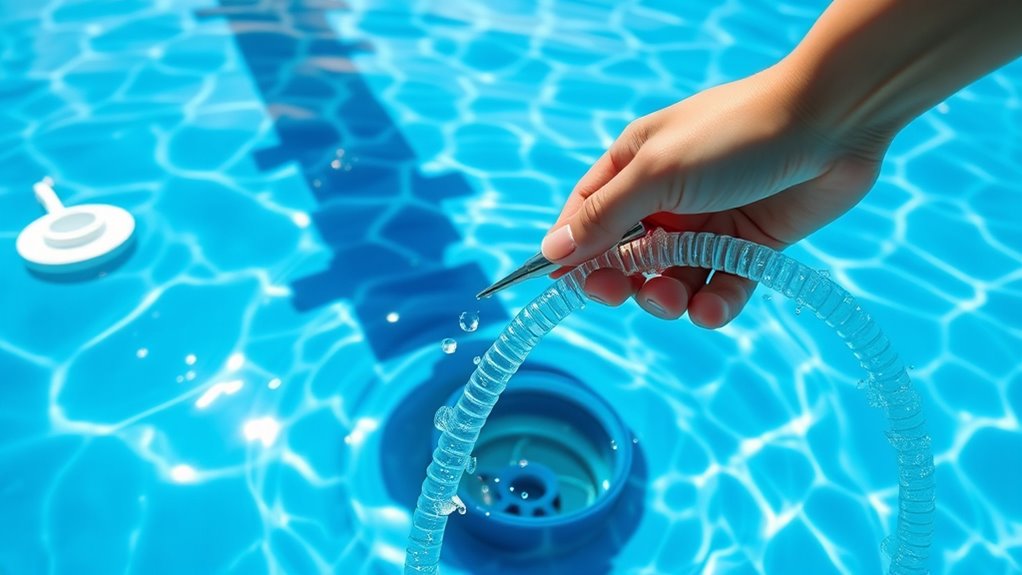
To keep your pool cleaner working smoothly, you need to check for any blockages in the lines and jets. Regularly cleaning the jets and removing debris helps maintain proper suction. Staying on top of these tasks prevents obstructions that could impair your cleaner’s performance. Using the right sound recording equipment can also ensure you capture clear audio during maintenance tutorials or instructional videos. Additionally, understanding industry transformations like AI automation can offer innovative solutions for diagnosing and maintaining pool equipment more efficiently. As AI develops new methods for detecting faults, it can further streamline the maintenance process and reduce downtime. Keeping an eye on celebrity lifestyle trends, such as private paradises, can also inspire personalized and luxurious pool designs for your home.
Check for Blockages
Blockages in your pool lines and jets can cause suction loss, so it’s essential to check for obstructions regularly. Start with blockage identification by inspecting the pipes and hoses for debris or buildup. Perform a thorough pipe inspection to locate any clogs that may hinder water flow. Use the table below to guide your checks:
| Step | Action |
|---|---|
| 1 | Visually inspect pipes and jets |
| 2 | Clear debris or obstructions |
| 3 | Test suction after cleaning |
Clean Pool Jets
Regularly cleaning your pool jets is essential for maintaining proper water flow and preventing suction loss. Start by inspecting the pool jet alignment to guarantee the jets are positioned correctly for maximum water flow. Misaligned jets can cause uneven suction and reduce cleaner efficiency. Next, check the jet nozzles for buildup or debris that could restrict water flow. Perform jet nozzle maintenance by removing any obstructions and cleaning them thoroughly. Properly aligned jets and clean nozzles help maintain consistent suction, preventing blockages that can impair your pool cleaner’s performance. Remember, neglecting jet maintenance can lead to decreased water flow and increased strain on your system. By keeping your pool jets clear and correctly aligned, you help assure smooth operation and extend the life of your cleaner.
Remove Debris Regularly
Keeping your pool lines and jets free of debris is key to maintaining proper suction and ensuring your cleaner works efficiently. Regular debris monitoring helps you catch blockages early, preventing suction loss. To keep things clear, focus on leaf removal and debris checks.
Here are four tips:
- Remove leaves and larger debris from the pool surface daily.
- Check and clear skimmer baskets regularly.
- Inspect and clean pool jets to prevent clogs.
- Use a brush or hose to dislodge debris stuck in lines or jets.
Adjust and Verify the Pool Cleaner’s Setup and Settings

To prevent suction loss, it’s vital to make certain your pool cleaner is properly set up and configured. First, check for any adjustments needed in the cleaner’s placement and ensure it’s evenly distributed across the pool floor. Verify that the hoses are connected correctly, with no kinks or twists that could restrict flow. Setting optimization involves adjusting the float and steering mechanisms to ensure consistent movement and suction. Make sure the cleaner’s skimmer and intake valves are fully open and positioned correctly. Confirm that the pressure and flow settings match the manufacturer’s recommendations. Regularly reviewing these setup details helps maintain ideal suction and cleaning efficiency, preventing issues caused by incorrect configuration. Proper adjustments and setting optimization are key to avoiding suction loss.
Replace Worn or Damaged Hoses and Seals Promptly

Damaged or worn hoses and seals can markedly reduce your pool cleaner’s suction, leading to poor performance and incomplete cleaning. Regular hose replacement and seal maintenance are essential to keep your cleaner working efficiently. To prevent suction loss, you should:
- Inspect hoses for cracks, leaks, or brittleness regularly.
- Replace any worn or damaged hoses immediately to restore proper flow.
- Check seals for cracks or deformities and replace them promptly.
- Ensure all connections are tight and secure after replacing hoses or seals.
Keep the Pool Filter Clean and Well-Maintained

A clean and well-maintained pool filter is essential for maintaining proper suction and ensuring your cleaner operates efficiently. Regular filter maintenance prevents debris buildup that can cause suction loss, while also reducing strain on your pump. To keep your filter in top shape, clean or replace the filter cartridge or DE grid as recommended. Monitoring pressure gauges helps identify when your filter needs attention, aiding in pump troubleshooting. A clogged filter not only hampers suction but can also damage your pump over time. Schedule routine cleaning, especially after heavy pool usage or storms. Remember, a well-maintained filter keeps your pool cleaner working smoothly, preventing issues before they start.
| Filter Maintenance Tip | Pump Troubleshooting Tip |
|---|---|
| Clean filter weekly | Check for air leaks |
| Replace worn filters | Inspect pump impeller |
| Backwash when needed | Verify pump pressure |
| Use the correct filter type | Ensure proper prime |
| Monitor pressure gauges | Check for unusual noises |
Use the Correct Size and Type of Pool Cleaner for Your Pool

Choosing the right size and type of pool cleaner is essential for maintaining ideal suction and efficient operation. Selecting the correct pool cleaner types ensures compatibility considerations are met, preventing suction loss. To do this effectively:
- Match the cleaner size to your pool’s dimensions for optimal coverage.
- Choose between robotic, suction-side, or pressure-side cleaners based on your pool’s shape and debris load.
- Check compatibility considerations with your existing pool equipment and skimmer size.
- Consider ease of use and maintenance when selecting a cleaner type.
Using the correct size and type minimizes strain on your system, reduces suction issues, and keeps your pool sparkling. Always review manufacturer guidelines to ensure your chosen pool cleaner aligns with your pool’s specifications.
Schedule Routine Maintenance and Professional Inspections
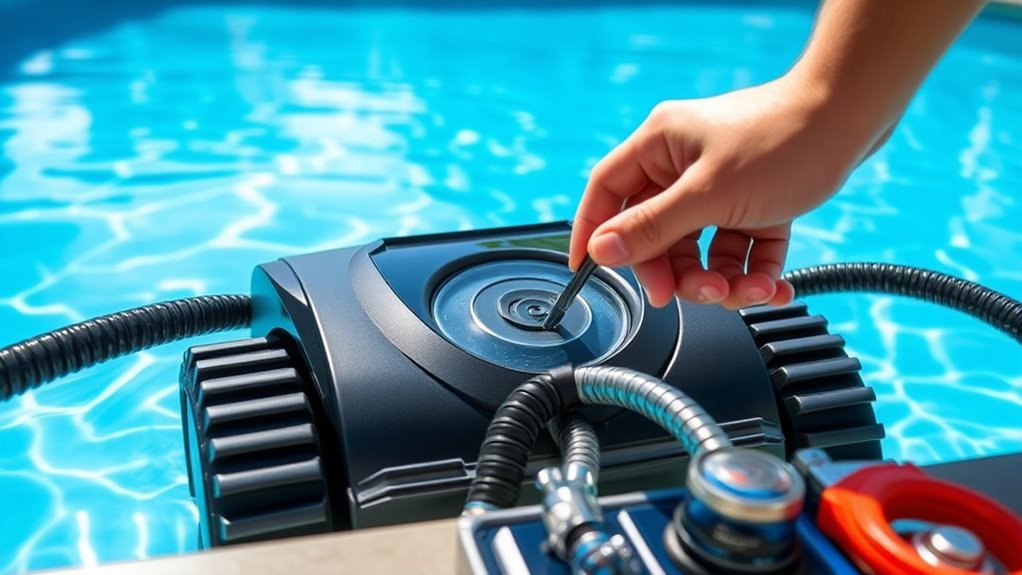
Scheduling routine maintenance and professional inspections is essential for keeping your pool cleaner functioning at its best. Regular checks help ensure proper pool chemical balance, which prevents algae buildup that can clog the cleaner’s suction. During inspections, professionals can identify issues like worn seals or clogged filters that may cause suction loss. Maintaining clean filters and ensuring hoses are in good condition keeps water flow steady and prevents suction disruptions.
| Maintenance Task | Frequency |
|---|---|
| Check pool chemical balance | Weekly |
| Inspect hoses and seals | Monthly |
| Clean filters | Bi-weekly |
| Professional inspection | Every 3-6 months |
Frequently Asked Questions
How Can I Tell if My Pool Cleaner Is Losing Suction?
You can tell if your pool cleaner is losing suction by paying attention to its performance. If the vacuum motor sounds weaker or there’s less debris pickup, it’s a sign. Check the pressure gauge; if it reads lower than usual, suction might be compromised. Also, observe if the cleaner moves sluggishly or doesn’t stick to the pool floor, indicating a loss of suction.
What Signs Indicate a Need to Replace Hoses or Seals?
If your pool cleaner isn’t performing well, it’s time to check the hoses and seals. Look for hose deterioration, such as cracks or brittleness, and seal degradation, like cracks or leaks around connections. These signs indicate it’s time to replace them, ensuring your cleaner maintains proper suction. Regular inspection helps you catch these issues early, so your pool stays clean and your equipment works efficiently.
Can Debris Buildup Cause Suction Loss Even if Filters Are Clean?
Did you know that debris buildup is responsible for about 80% of suction loss cases? Even if your filters look clean, debris accumulation can clog hoses or pump intakes, reducing pump pressure. This causes suction loss in your pool cleaner. Regularly inspect and clear out debris, especially around the pump and hoses, to maintain ideal pump pressure and guarantee your cleaner works efficiently without losing suction.
How Often Should I Inspect the Pool’S Plumbing for Leaks?
You should inspect your pool’s plumbing for leaks at least once a month. Regular checks help maintain proper pool chemical balance and prevent issues that could cause suction loss. Look for wet spots, decreased water levels, or air bubbles in the skimmer. Also, verify your pool cover maintenance is up-to-date, as a well-maintained cover reduces debris buildup that can strain your plumbing, keeping everything functioning smoothly.
Are There Specific Pool Types More Prone to Suction Issues?
Like a delicate dance between water and air, some pool types are more prone to suction issues. You’re more likely to experience problems with vinyl or above-ground pools, where flexible walls can shift and disrupt flow. Regular automatic pool maintenance and maintaining proper chemical balance help keep the system steady. Being attentive to these factors guarantees your pool’s harmony remains intact, preventing suction loss and keeping your cleaning routine smooth.
Conclusion
By regularly inspecting and maintaining your pool equipment, you’re the captain steering a smooth, uninterrupted voyage beneath the water’s surface. Think of each small step—cleaning filters, checking hoses—as setting the course straight to crystal-clear, hassle-free swimming. When you stay vigilant, you’re not just preventing suction loss; you’re creating a haven where every swim feels like a invigorating breeze, inviting perfection with every dip. Keep up the care, and your pool will always be ready for the next adventure.
